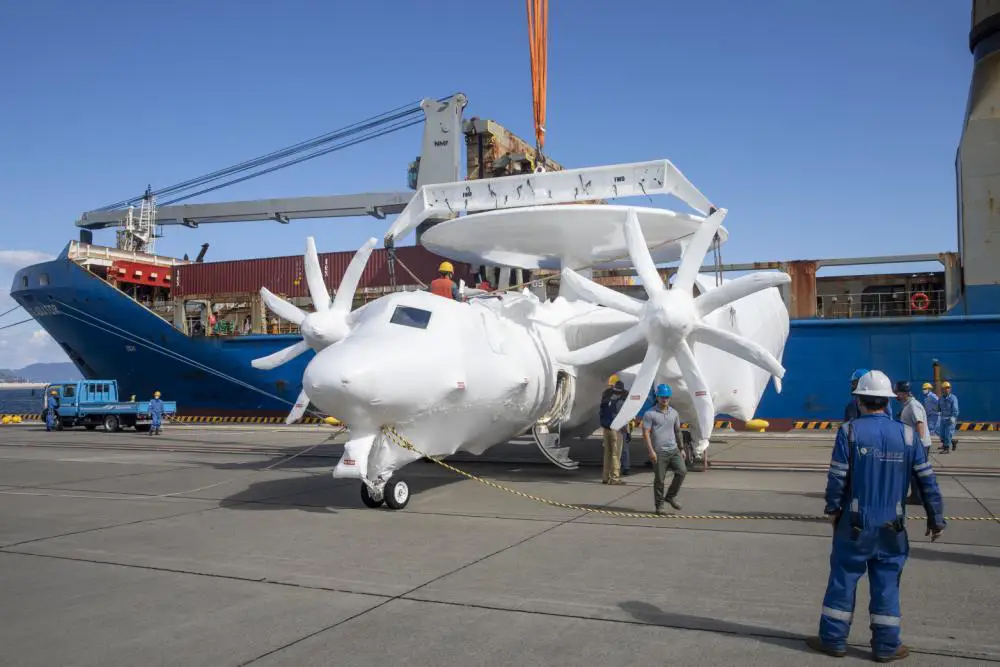The US Marine Corps has unloaded an E-2D Advanced Hawkeye airborne early warning (AEW) aircraft from a cargo ship onto the Marine Corps Air Station Iwakuni for its delivery to the Japan Air Self-Defense Force (JASDF, Koku Jieitai). Following assembly and some test flights at Iwakuni, the aircrafts, which belong to an initial batch, are set to be transferred to the JASDF’s 601st Squadron and 603rd Squadron, which operates both E-2C and E-2D aircraft, is based. In the early 2010s the amount of air activity by China near Okinawa increased dramatically after Japan effectively nationalized the disputed Senkaku Islands, sparking a major backlash from China. Beginning in 2012 E-2C aircraft of the squadron began deploying to Naha Air Base as required, and in 2014 603rd Squadron was officially formed by taking around 130 personnel and four of the squadron’s 13 E-2C aircraft from Misawa Air Base in Aomori Prefecture.

The Northrop Grumman E-2 Hawkeye is an American all-weather, carrier-capable tactical airborne early warning (AEW) aircraft. The E-2 also received the nickname “Super Fudd” because it replaced the WF (later E-1) “Willy Fudd”. The aircraft’s performance has been upgraded with the E-2B, and E-2C versions, where most of the changes were made to the radar and radio communications due to advances in electronic integrated circuits and other electronics. The fourth major version of the Hawkeye is the E-2D, which first flew in 2007. The E-2 was the first aircraft designed specifically for its role, as opposed to a modification of an existing airframe, such as the Boeing E-3 Sentry. Variants of the Hawkeye have been in continuous production since 1960, giving it the longest production run of any carrier-based aircraft.

Japan Air Self-Defence Force has operated the Northrop Grumman E-2C Hawkeye since 1983 and is the largest E-2 operator outside the U.S. The E-2D delivers a two-generation leap in radar technology, allowing the aircraft to track threats at extended range. The aircraft can also be used in a humanitarian assistance and disaster relief capacity for civilian emergency coordination. The E-2D offers interoperability with next-generation aircraft systems and U.S. Navy allies to support regional security cooperation. To ensure long-term success of the Japan E-2D fleet, Northrop Grumman is providing continued support to JASDF in the areas of sustainment and maintenance, in coordination with several Japanese firms.

The U.S State Department has made a determination approving a possible Foreign Military Sale to Japan of up to nine (9) E-2D Advanced Hawkeye (AHE) Airborne Early Warning and Control (AEW&C) aircraft for an estimated cost of $3.135 billion. The Government of Japan has requested to buy up to nine (9) E-2D Advanced Hawkeye (AHE) Airborne Early Warning and Control (AEW&C) aircraft, twenty eight (28) T56-A-427A engines, twelve (12) Multifunction Information Distribution System/Joint Tactical Radio System (MIDS/JTRS) terminals, ten (10) APY-9 Radars, eleven (11) AN/AYK-27 Integrated Navigation Control and Display Systems (INCDS), thirty (30) LN-251 Embedded Global Positioning Systems/Inertial Navigation Systems (EGIs) with Embedded Airborne Selective Availability Anti-Spoofing Module (SAASM) Receiver, and twelve (12) AN/ALQ-217 Electronic Support Measures.
















